Root Canal Diagnosis
PATIENT REVIEWS
One of the advantages of Dr. Edalat’s cosmetic dental studio is that you can complete your entire treatment by certified specialists who communicate in detail all aspects of the treatment that are interrelated for optimal results. Most patients don’t like the inconvenience of having to go to different offices to complete their work. There is also the risk that the timing sequence to complete a certain treatment when it is being done at different offices may compromise the final result. Also since the work is being done in different offices there may be a mis communication between the referring doctors which may also compromise the final result.

Root canal therapy
When the pulp of a tooth becomes infected or dies, root canal therapy is necessary to save the tooth. It is generally a comfortable treatment that can save your tooth and keep your mouth healthy.
Symptoms of infection
You may realize that you have an infected tooth when you feel one or more of the symptoms below—
- The tooth is sensitive to hot or cold.
- The tooth hurts with biting or pressure.
- There is throbbing, severe tooth pain especially when lying down at night.
- The area is swollen.
- You have a bad taste in your mouth.
Causes of infection
The pulp becomes infected when bacteria invade the inner layers of the tooth. The tooth pulp is a soft tissue made up of nerves and blood vessels. It is contained in the pulp chamber that extends from the middle of the tooth down through the tooth roots.
Infection occurs most commonly through a deep cavity that allows bacteria through the enamel and dentin layers and into the pulp. Sometimes the pulp simply dies due to a fracture or a blow to the tooth.
Diagnosis and treatment
To determine if your tooth has an infected pulp, we do a thorough examination. The exam often includes x-rays and sometimes includes checking the health of the pulp with a pulp tester. We may also apply heat or cold, tap lightly on the tooth to see if it is sensitive, look for changes in the tooth’s color, or press gently on the gums next to the tooth to check for pain.
If we determine that you have an infected tooth, we talk with you about root canal therapy to remove the infection and save the tooth. It is important to treat an infected tooth in order to prevent the infection from traveling through the root tips and causing a painful abscess in the jawbone. Sometimes a chronic infection may become life threatening because it can spread to the heart muscle or brain in which case you may need to perform heart surgery, etc…Therefore the sooner you treat an infected tooth the better because there will be less loss of tooth structure, which will facilitate its restoration after the root canal therapy.
Alternatives to Root Canal Therapy
 Infection spreading from cracked tooth to pulp chamber
Infection spreading from cracked tooth to pulp chamber
PATIENT EDUCATION VIDEOS
Alternatives to Root Canal

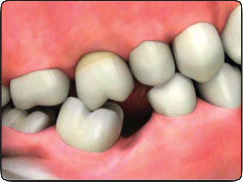
Treatment alternatives
Once the inner pulp layer of a tooth has become infected, your choices are limited. You could choose to —
- extract the tooth.
- delay treatment.
- save the tooth with root canal therapy.
Extracting the tooth
An extraction is only a short-term solution because teeth need each other for support. While an extraction does remove the infection, a missing tooth sets off a chain reaction of shifting teeth, receding jawbone, increased risk for decay and gum disease, and other dental problems.
Delaying treatment
If you choose to delay treatment, you should know that an infected tooth will never heal on its own. As the infection spreads down the tooth and into your jawbone, the pain may become excruciating. The infection also can become more wide-spread and potentially threaten your life.
Choosing root canal therapy
When the pulp of the tooth has been infected, root canal therapy is the best choice for removing infection, saving your tooth, and keeping your mouth and smile healthy.
PATIENT EDUCATION VIDEOS
Pulpitis


Any time the pulp of a tooth has been injured or irritated, there is a possibility that it may become swollen and painful. This inflammation is called pulpitis. Treating the condition will relieve discomfort and restore the health of your mouth.
Symptoms of pulpitis
You may realize that you have an inflamed tooth when:
- The tooth is sensitive to hot, cold, or pressure.
- The tooth hurts with biting.
- There is throbbing tooth pain.
- The area is swollen.
- The tooth is loose.
- You have a bad taste in your mouth.
You may also be unaware of the problem because there are no symptoms at all.
Causes of pulpitis
The tooth pulp is a soft tissue made up of nerves and blood vessels. It is contained in the pulp chamber that extends from the middle of the tooth down through the tooth roots.
The pulp can become inflamed for a number of reasons. Occasionally, placing a filling, crown, or other restoration close to the pulp can cause inflammation. Other times, the pulp may become inflamed due to an injury. In both these cases, the pulp may calm down on its own, but sometimes it can die or become infected.
The pulp also can become infected when tooth decay destroys the outer layers of the tooth and allows bacteria to invade the pulp layer. Sometimes the condition occurs for no apparent reason.
Diagnosis and treatment
To select the best treatment, we do a thorough examination. The examination often includes x-rays and sometimes includes checking the health of the pulp with a pulp tester. We may also apply heat or cold, tap lightly on the tooth to see if it is sensitive, look for changes in the tooth’s color, or press gently on the gums next to the tooth to check for pain.
If the pulp is mildly inflamed, we may recommend treatments to ease any discomfort and help the tooth heal.
If the pulp cannot heal itself or is infected, we recommend root canal therapy to remove the infection and save the tooth.
PATIENT EDUCATION VIDEOS
Pulp Capping


Keeping a tooth healthy
Whenever we must place a restoration close to the pulp of a tooth, there is a possibility that the pulp can become irritated or inflamed. In some cases, we may be able to keep the pulp healthy with a pulp capping procedure.
The procedure
The pulp capping procedure is used after decay has been removed from the tooth and before we place the filling, crown, or other restoration.
The first step is to determine whether pulp capping is right for your tooth. We confirm that there is no pain in the tooth and that the pulp is healthy and free of infection.
After we make sure that all the decay has been removed, we clean and disinfect the area. Then a special material is placed over the pulp chamber. This stimulates the inner tooth structure to repair itself and seal bacteria out of the pulp chamber.
Depending on your situation, we may place a temporary restoration, or we may place the final filling or crown. After the procedure is complete, we monitor the tooth for several months to make sure the pulp is healing.
The benefits of pulp capping
When pulp capping is successful, the procedure can soothe a tooth’s irritated pulp and help it to heal, seal out bacteria, and prevent the need for root canal therapy.
PATIENT EDUCATION VIDEOS
Apicoectomy Surgery
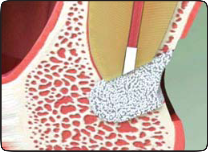 Apicoectomy Surgical Procedure
Apicoectomy Surgical Procedure
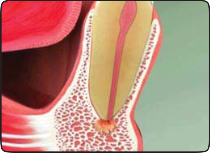
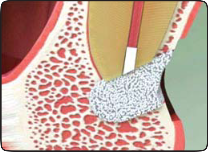
When a tooth does not completely heal
An apicoectomy is a minor surgical procedure that is necessary when root canal therapy has not healed an infected tooth completely. Even after root canal therapy, infection sometimes may continue to grow at the tip of the tooth root, where it can dissolve jawbone and form a painful abscess.
The procedure
First, we numb the area to keep you completely comfortable throughout the procedure. Then we make a small incision in the gums next to the tooth’s root. We carefully remove the thin bone covering the tooth’s root so we can access it.
We then remove the infected tissue at the root tip and seal the root with a filling material. In some cases, we may place bone grafting material into the space to help the bone to regrow around the root. Last, we replace the gum tissue and stitch it back into place.
The bone tissue will heal to fill in the area around the tip of your tooth’s root, and your tooth will once again be healthy and pain free.
The benefits of an apicoectomy
An apicoectomy removes infection, relieves pain, and helps healthy bone to grow in around the root. It is an important procedure that can save your tooth.
PATIENT EDUCATION VIDEOS
Root Canal Retreatment
Narrow, curved and branched canals



Reasons that a tooth does not properly heal
In some cases, root canal therapy doesn’t completely heal an infected tooth, and root canal retreatment becomes necessary.
There are several reasons why the infected tooth may not have healed completely.
- The tooth may have canals that are difficult to clean because they are narrow, curved, or branched.
- The tooth may have extra root canals that were not discovered the first time.
- Tooth decay or a fracture can expose the filling material in the roots to bacteria, causing new infection.
Sometimes there is no apparent reason.
The procedure
We start the retreatment procedure by numbing the area to make you comfortable. We may also use a rubber dam to protect your mouth and ensure that nothing falls to the back of your throat while we work.
We make an opening through the top of the tooth and down into the pulp chamber. Then we remove the filling material that was previously placed in the root canals.
We carefully search for additional canals, remove any infection, and place new filling material in the canals. Last, depending on the circumstances, we seal the tooth with a small filling or replace the crown with a new one.
The benefits of root canal retreatment
Root canal retreatment removes infection, relieves discomfort, and saves your tooth. With modern dental techniques, it is a generally comfortable and effective procedure.
PATIENT EDUCATION VIDEOS
Single Visit Root Canal Therapy
Root canal therapy
When the pulp layer of a tooth becomes infected, it is necessary to remove the infection with root canal therapy. It is a generally comfortable procedure that saves your tooth and gives you back your healthy smile.
The procedure
We start the procedure by numbing the area completely to keep you comfortable. We may also place a rubber dam around the infected tooth to protect your mouth and ensure that nothing falls to the back of your throat while we work.
To get at the infected tooth pulp, we make an opening through the top of the tooth, down into the pulp chamber. We use a tiny instrument called a dental file to carefully clean out the infected tissue and shape the root canals to receive a filling material. To make sure that all of the infected pulp is removed, we may take x-rays or use other instruments.
Finally, we begin the steps necessary to restore the tooth. In most cases, we recommend placing a crown to protect and strengthen your tooth. If the tooth is severely broken down, it may be necessary to start by building up the tooth with a post and core.
The benefits of root canal therapy
Root canal therapy saves your tooth, prevents the spread of infection, and helps you maintain the health of your mouth.
PATIENT EDUCATION VIDEOS
Two Visit Root Canal Therapy
 Filling root canals
Filling root canals


Root canal therapy
When the pulp layer of a tooth becomes infected, it is necessary to remove the infection with root canal therapy. In some cases, we need to schedule two appointments to complete the treatment. It is a generally comfortable procedure that saves your tooth and gives you back your healthy smile.
The procedure
At the first appointment, we start the procedure by numbing the area completely to keep you comfortable. We may also place a rubber dam around the infected tooth to protect your mouth and ensure that nothing falls to the back of your throat while we work.
To get at the infected tooth pulp, we make an opening through the top of the tooth, down into the pulp chamber. We use a tiny instrument called a dental file to carefully clean out the infected tissue and shape the root canals to receive a filling material.
To make sure that all of the infected pulp is removed, we may take x-rays or use other instruments. We then put medicine in the tooth to help it heal and place a temporary restoration to seal it.
At the second appointment, we again make sure you are completely comfortable. Then we remove the temporary restoration and place a filling material into the root canals to seal them.
Finally, we begin the steps necessary to restore the tooth. In most cases, we recommend placing a crown to protect and strengthen your tooth. If the tooth is severely broken down, it may be necessary to start by building up the tooth with a post and core.
The benefits of root canal therapy
Root canal therapy saves your tooth, prevents the spread of infection, and helps you maintain the health of your mouth.
PATIENT EDUCATION VIDEOS
What is an Endodontic Abscess?
 Endodontic abscess at root tip
Endodontic abscess at root tip

An endodontic abscess forms at the root tip
An endodontic abscess is a pocket of pus that forms in the jawbone at the tip of a tooth root.
An endodontic abscess is painful and can lead to much more serious conditions, but with prompt treatment, we can help you maintain a healthy mouth and body.
Symptoms of an endodontic abscess
- You may realize that you have an endodontic abscess when—
- the tooth hurts when you tap or bite on it.
- you have a bad taste in your mouth.
- you experience pain and swelling.
It is also possible that you can have an endodontic abscess and experience no symptoms at all.
The causes of an endodontic abscess
An endodontic abscess is caused by an infection of the pulp layer of the tooth. It becomes infected when bacteria, which are always present in the mouth, invade the pulp through deep cavities, a fractured or broken tooth, or an injury to the tooth. In some cases, there is no apparent reason.
The infection can then spread from the pulp chamber, down the root canals, through the tip of the root, and into the jawbone, where the pus builds up and creates a hole in the bone. This is the abscess.
The abscess creates pressure inside the bone and on the ligaments surrounding the tooth, and this can cause excruciating pain. Sometimes, the abscess drains near the infected tooth, forming a gumboil.
Diagnosis and treatment
It is important to treat an endodontic abscess because, if left untreated, the abscess can damage the adjacent soft tissue, lead to bone loss, be a continuing source of infection that drags down your immune system, and even be life-threatening.
To find an endodontic abscess, we perform a thorough examination, including x-rays. On the x-ray above, you can see a dark area at the root tip, which indicates an endodontic abscess. We may also use an electric pulp tester to determine whether the pulp is inflamed or infected.
An infected tooth will never heal on its own, so we remove the infection with root canal therapy, which allows the abscess to heal. Occasionally, however, the infection continues to grow after treatment. In that case, we may retreat the tooth with root canal therapy or use a minor surgical procedure to stop the infection and restore the health of your tooth.
PATIENT EDUCATION VIDEOS
Why a root canal after a crown?

Why we place a crown
If you have a crown, it was placed because the outside of the tooth was damaged and needed more than just a filling. But the crown doesn’t protect the inside of the tooth, called the pulp.
The pulp contains the nerves, blood and veins that keep the tooth alive. If this pulp becomes infected it will need root canal therapy.
Infected pulp will not heal on its own. If we don’t perform root canal therapy, the infection can spread and cause a painful abscess.
When do we place a crown?
There is no way to predict when the need for root canal therapy might occur. But, because the tooth was damaged enough to need a crown, it is likely the pulp is in a compromised state.
In some cases, we may be able to enter through the crown. Once we clean and repair the root canals, we can simply restore the crown much like we’d restore a natural tooth.
Otherwise, we may have to remove the crown in order to remove the infected pulp and treat the roots. We’ll then need to create and place a new crown.
Root canal therapy, even on a crowned tooth, is done to help save the tooth. It’s our goal to give you a healthy, beautiful smile.
PATIENT EDUCATION VIDEOS
Cast Post & Core Restorations
 Crown is placed over cast post & core bad2 bad2 bad2
Crown is placed over cast post & core bad2 bad2 bad2
Cast Post & Core
Replacing a missing portion of a tooth when a tooth is severely broken down, there may not be enough tooth structure to securely hold a crown. We use a cast post and core to replace the missing portion of the tooth. A cast post and core is a one-piece unit. The post section is placed into the inner part of the tooth, and the core provides a foundation for a crown. It is precision-crafted in a dental laboratory, so the procedure may take two or more appointments.
The procedure
The procedure is performed after the tooth has been treated with root canal therapy and before placing the crown. On your first visit, we numb the area completely to keep you comfortable. We may also place a rubber dam to protect your mouth while we work. Then we remove any decay and shape the tooth to accept the final crown. We remove some of the filling material that was placed into the roots of the tooth during the root canal procedure. Then a space is prepared in the inner part of the tooth for the post and core. Next we make a specialized impression that will provide the exact dimensions of both the inner and outer portions of the tooth. Using the impression, the lab makes the post and core to precisely fit your tooth and the final crown. In the meantime, we usually place a temporary crown to protect your tooth. On your next visit, we remove the temporary, cement in the new post and core, and then adjust it if necessary. Last, we place the crown. The benefits of a cast post and core Placing a cast post and core in a tooth prior to placing a crown—
- Strengthens the tooth
- Provides stability for the crown
A cast post and core procedure is an important step in saving a tooth that has been severely damaged by fracture or decay.
PATIENT EDUCATION VIDEOS
Crowns & Root Canal
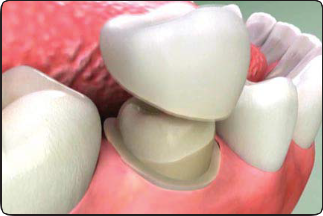
After a tooth has had root canal therapy, we recommend placing a crown on the tooth. Root canal therapy reduces the strength of the tooth, and a crown can cover and protect it.
How does root canal therapy affect a tooth?
Root canal therapy leaves a tooth brittle and weak. The inner pulp layer of a tooth contains its nerves and blood vessels, so the tooth loses much of its blood supply when the infected pulp is removed and the tooth’s root canals are cleaned out. The tooth is weaker also because only the sides of the tooth are left for support when the center of the tooth is gone.
These factors make it much easier for a tooth to break when you bite down on food. Biting and chewing place a tremendous amount of force on teeth, and weak, brittle teeth are especially vulnerable.
A crown protects the tooth
A crown can prevent these problems by covering and protecting the tooth and restoring its strength and shape.
There are many kinds of crowns, including crowns made of gold, porcelain-fused-to-metal, and porcelain. We’ll talk with you about the best one for your situation to help you keep your healthy and beautiful smile.
PATIENT EDUCATION VIDEOS
Post-op instructions for a Root Canal Therapy
Caring for a temporary restoration
Now that you have had root canal therapy, it is important to follow these recommendations to ensure healing.
If we placed a temporary filling or crown on your tooth, avoid chewing for at least one-half hour to allow the restoration to harden.
To keep your temporary restoration in place, avoid eating hard or sticky foods, especially chewing gum. If possible, chew only on the opposite side of your mouth.
It is not a problem for a small portion of a temporary filling to wear away or break off, but if the entire filling wears out, or if a temporary crown comes off, call us so that it can be replaced.
Chewing and eating
If we used an anesthetic during the procedure, avoid chewing until the numbness has completely worn off. Your lips, teeth, and tongue may be numb for several hours.
Brushing and flossing
Brush and floss normally.
Medications and discomfort
If antibiotics were prescribed, continue to take them for the indicated length of time, even if all symptoms and signs of infection are gone.
To control discomfort, take pain medication before the anesthetic has worn off or as recommended. It is normal to experience some discomfort for several days after a root canal appointment, especially when chewing.
To further reduce discomfort or swelling, rinse your mouth three times a day with warm salt water. Use about one teaspoon of salt per glass of warm water.
When to call us
Call our office if your bite feels uneven, if you have sensitivity or discomfort that increases or continues beyond three or four days, if your temporary filling or crown comes off, or if you have any questions or concerns.
PATIENT REVIEWS
My husband and I both needed extensive dental work…and so, we actually flew to New York to see Dr. Edalat, after meeting one of his students who had raved about Dr. Edalat and his office. Both my husband and I feel and look so much better after our treatment. We wouldn’t dream of seeing any other dentist ever again!”
Louise C. – Kent, England

 Google
Google Yahoo
Yahoo Yelp
Yelp Insider Pages
Insider Pages Healthgrades
Healthgrades CitySearch
CitySearch Wellness
Wellness




